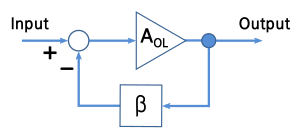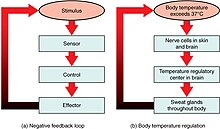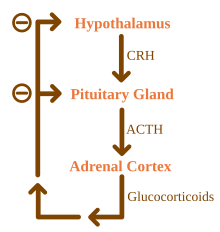| Revision as of 16:59, 11 June 2014 editBrews ohare (talk | contribs)47,831 editsmNo edit summary← Previous edit | Revision as of 05:17, 13 June 2014 edit undoDicklyon (talk | contribs)Autopatrolled, Extended confirmed users, Rollbackers477,552 edits →Overview: number agreementNext edit → | ||
| Line 132: | Line 132: | ||
| </ref> While in a psychology context, ''negative'' refers to the ] of the feedback - how unhappy it makes the recipient.<ref name=herold1977>Herold, David M., and Martin M. Greller. "Research Notes. FEEDBACK THE DEFINITION OF A CONSTRUCT." Academy of management Journal 20.1 (1977): 142-147.</ref> | </ref> While in a psychology context, ''negative'' refers to the ] of the feedback - how unhappy it makes the recipient.<ref name=herold1977>Herold, David M., and Martin M. Greller. "Research Notes. FEEDBACK THE DEFINITION OF A CONSTRUCT." Academy of management Journal 20.1 (1977): 142-147.</ref> | ||
| In contrast, ] is feedback in which the system responds so as to increase the magnitude of any particular perturbation, resulting in amplification of the original signal instead of stabilization. Any system in which there is positive feedback together with a gain greater than one will result in a runaway situation. Both positive and negative feedback |
In contrast, ] is feedback in which the system responds so as to increase the magnitude of any particular perturbation, resulting in amplification of the original signal instead of stabilization. Any system in which there is positive feedback together with a gain greater than one will result in a runaway situation. Both positive and negative feedback require a feedback loop to operate. | ||
| == Use == | == Use == | ||
Revision as of 05:17, 13 June 2014


Negative feedback occurs when the result of a process influences the operation of the process itself in such a way as to reduce changes. Feedback can produce stability and reduce the effect of fluctuations. Negative feedback loops in which just the right amount of correction is applied in the most timely manner can be very stable, accurate, and responsive.
The upper figure shows a negative feedback amplifier in which the feedback sets the overall ('closed-loop') amplifier gain at a value 1/β independent of variations in the 'open-loop' gain AOL (for example, due to manufacturing variations between units, or temperature effects upon components) provided only that this gain is sufficiently large. There are other advantages to feedback in amplifiers.
A different use of feedback, shown in the lower figure, is to make a system self-regulating. Using a negative feedback loop, a measurement of some variable (for example, a process variable) is subtracted from a required value (the 'set point') to estimate the current error, which is then used to reduce the gap between the measurement and the required value. The error may be introduced by a variety of possible disturbances or 'upsets', some slow and some rapid. The 'controller' in such systems can range from a simple 'on-off' control to a more complex processing of the error signal.
It may be noted that the signals in the system change form from point to point. So, for example, a disturbance in heat input to a house (maybe a change in weather) is interpreted by a thermometer as a change in temperature, converted by the thermostat into an electrical error signal to the controller that commands gas control valves and an ignitor, ultimately changing the heat provided by a furnace to counteract the initial disturbance in heat input to the house.
Negative feedback is widely used in mechanical and electronic engineering, but it also occurs naturally within living organisms, and can be seen in many other fields from chemistry and economics to social behavior and the climate. General negative feedback systems are studied in control systems engineering. A more qualitative application of feedback is found in educational and management assessment, which is related by Roos and Hamilton to the early work on cybernetics by Norbert Wiener.
History
Negative feedback as a control technique may be seen in the refinements of the water clock introduced by Ktesibios of Alexandria in the 3rd century BCE. Self-regulating mechanisms have existed since antiquity, and were used to maintain a constant level in the reservoirs of water clocks as early as 200 BCE. Cornelius Drebbel had built thermostatically-controlled incubators and ovens in the early 1600s, James Watt regulated the speed of the steam engine using a governor patented by in 1788, and James Clerk Maxwell in 1868 described "component motions" associated with these governors that lead to a decrease in a disturbance or the amplitude of an oscillation.
The general idea of feedback was well established by the 1920s, in reference to a means of boosting the gain of an electronic amplifier. Friis and Jensen described this action as "positive feedback" and made passing mention of a contrasting "negative feed-back action" in 1924. Harold Stephen Black detailed the use of negative feedback in electronic amplifiers in 1934, where he defined negative feedback as a type of coupling that reduced the gain of the amplifier, in the process greatly increasing its stability and bandwidth. Nyquist and Bode built on Black’s work to develop a theory of amplifier stability, but chose to define "negative" as applying to the polarity of the loop (rather than the effect on the gain), which gave rise to some confusion over basic definitions.
Early researchers in the area of cybernetics subsequently generalized the idea of negative feedback to cover any goal-seeking or purposeful behavior.
All purposeful behavior may be considered to require negative feed-back. If a goal is to be attained, some signals from the goal are necessary at some time to direct the behavior.
Cybernetics pioneer Norbert Wiener helped to formalize the concepts of feedback control, defining feedback in general as "the chain of the transmission and return of information", and negative feedback as the case when:
The information fed back to the control center tends to oppose the departure of the controlled from the controlling quantity...
While the view of feedback as any "circularity of action" helped to keep the theory simple and consistent, Ashby pointed out that it can clash with definitions in other fields that require "a more tangible connexion."
practical experimenters and constructors ... want to use the word to refer, when some forward effect from P to R can be taken for granted, to the deliberate condition of some effect back from R to P by some connexion that is physically or materially evident.
Further confusion arose after BF Skinner introduced the terms positive and negative reinforcement, both of which can be considered negative feedback mechanisms in the sense that they try to minimize deviations from the desired behavior. In a similar context, Herold and Greller used the term "negative" to refer to the valence of the feedback: that is, cases where a subject receives an evaluation with an unpleasant emotional connotation.
A common theme for the 10 items is their valence, all representing negative feedback. Examples are being removed from a job or suffering some adverse consequence due to poor performance or receiving more or less direct indications of dissatisfaction from co-workers or the supervisor.
To reduce confusion, later authors have suggested alternative terms such as degenerative, self-correcting, balancing, or discrepancy-reducing in place of "negative".
Overview

In many physical and biological systems, qualitatively different influences can oppose each other. For example, in biochemistry, one set of chemicals drives the system in a given direction, whereas another set of chemicals drives it in an opposing direction. If one or both of these opposing influences are non-linear, equilibrium point(s) result.
In biology, this process (in general, biochemical) is often referred to as homeostasis; whereas in mechanics, the more common term is equilibrium.
In engineering, mathematics and the physical, and biological sciences, common terms for the points around which the system gravitates include: attractors, stable states, eigenstates/eigenfunctions, equilibrium points, and setpoints.
In control theory, negative refers to the sign of the multiplier in mathematical models for feedback. In delta notation, −Δoutput is added to or mixed into the input. In multivariate systems, vectors help to illustrate how several influences can both partially complement and partially oppose each other.
Some authors, in particular with respect to modelling business systems, use negative to refer to the reduction in difference between the desired and actual behavior of a system. While in a psychology context, negative refers to the valence of the feedback - how unhappy it makes the recipient.
In contrast, positive feedback is feedback in which the system responds so as to increase the magnitude of any particular perturbation, resulting in amplification of the original signal instead of stabilization. Any system in which there is positive feedback together with a gain greater than one will result in a runaway situation. Both positive and negative feedback require a feedback loop to operate.
Use
Mechanical engineering

Negative feedback was first implemented in the 16th Century with the invention of the centrifugal governor. Its operation is most easily seen in its use by James Watt to control the speed of his steam engine. Two heavy balls on an upright frame rotate at the same speed as the engine. As their speed increases they swing up and outwards due to centrifugal force. This causes them to lift a mechanism that closes the steam inlet valve, and the engine slows. When the speed of the engine falls too far, the balls will fall by gravity and open the steam valve.
Control systems

Examples of the use of negative feedback to control its system are: thermostat control, phase-locked loop, hormonal regulation (see diagram above), and temperature regulation in animals.
A simple and practical example is a thermostat. When the temperature in a heated room reaches a certain upper limit, the room heating is switched off so that the temperature begins to fall. When the temperature drops to a lower limit, the heating is switched on again. Provided the limits are close to each other, a steady room temperature is maintained. Similar control mechanisms are used in cooling systems, such as an air conditioner, a refrigerator, or a freezer.
Biology and chemistry

Some biological systems exhibit negative feedback such as the baroreflex in blood pressure regulation and erythropoiesis. Many biological process (e.g., in the human anatomy) use negative feedback. Examples of this are numerous, from the regulating of body temperature, to the regulating of blood glucose levels. The disruption of feedback loops can lead to undesirable results: in the case of blood glucose levels, if negative feedback fails, the glucose levels in the blood may begin to rise dramatically, thus resulting in diabetes.
For hormone secretion regulated by the negative feedback loop: when gland X releases hormone X, this stimulates target cells to release hormone Y. When there is an excess of hormone Y, gland X "senses" this and inhibits its release of hormone X.
Economics
In economics, automatic stabilisers are government programs that work as negative feedback to dampen fluctuations in real GDP.
Electronic amplifiers
Main article: Negative feedback amplifierThe negative feedback amplifier was invented by Harold Stephen Black at Bell Laboratories in 1927, and patented by him in 1934. Fundamentally, all electronic devices (e.g., vacuum tubes, bipolar transistors, MOS transistors) exhibit some nonlinear behavior. Negative feedback corrects this by trading unused gain for higher linearity (lower distortion). An amplifier with too large an open-loop gain, possibly in a specific frequency range, will also produce too large a feedback signal in that same range. This feedback signal, when subtracted from the original input, will act to reduce the original input, also by "too large" an amount. This "too small" input will be amplified again by the "too large" open-loop gain, creating a signal that is "just right". The net result is a flattening of the amplifier's gain over all frequencies (desensitising). Though much more accurate, amplifiers with negative feedback can become unstable if not designed correctly, causing them to oscillate. Harry Nyquist of Bell Laboratories managed to work out a theory about how to make this behaviour stable.
Negative feedback is used in this way in many types of amplification systems to stabilize and improve their operating characteristics (see e.g., operational amplifiers).
See also
- Asymptotic gain model
- Biofeedback
- Control theory
- Cybernetics
- Global warming
- Nyquist stability criterion
- Perceptual control theory
- Positive feedback
- Stability criterion
- Step response
References
-
Wai-Kai Chen (2005). "Chapter 13: General feedback theory". Circuit Analysis and Feedback Amplifier Theory. CRC Press. p. 13-1. ISBN 9781420037272.
the forward path may not be strictly unilateral, the feedback path is usually bilateral, and the input and output coupling networks are often complicated.
- Sudheer S Bhagade, Govind Das Nageshwar (2011). Process Dynamics and Control. PHI Learning Pvt. Ltd. pp. 6, 9. ISBN 9788120344051.
- Santiram Kal (2009). "§6.3 Advantages of negative feedback amplifiers". Basic electronics: Devices, circuits and its fundamentals. PHI Learning Pvt. Ltd. pp. 193 ff. ISBN 9788120319523.
- SK Singh (2010). Process Control: Concepts Dynamics And Applications. PHI Learning Pvt. Ltd. p. 222. ISBN 9788120336780.
-
For example, input and load disturbances. See William Y. Svrcek, Donald P. Mahoney, Brent R. Young (2013). A Real-Time Approach to Process Control (3rd ed.). John Wiley & Sons. p. 57. ISBN 9781118684733.
{{cite book}}: CS1 maint: multiple names: authors list (link) -
Charles D H Williams. "Types of feedback control". Feedback and temperature control. University of Exeter: Physics and astronomy. Retrieved 6/8/2014.
{{cite web}}: Check date values in:|accessdate=(help) - Robert E. Ricklefs, Gary Leon Miller (2000). "§6.1 Homeostasis depends upon negative feedback". Ecology. Macmillan. p. 92. ISBN 9780716728290.
-
Bertil Roos, David Hamilton (March, 2005). "Formative and Summative Assessment: A cybernetic viewpoint" (PDF). Assessment in Education Principles Policy and Practice. 12: 7–20.
{{cite journal}}: Check date values in:|date=(help) - Gary E Davis, Merecedes A McGowan (2007). "Formative feedback and the mindful teaching of mathematics" (PDF). Australian Senior Mathematics Journal. 21 (1): 19.
- ^ Arkalgud Ramaprasad (1983). "On The Definition of Feedback". Behavioral Science. 28 (1). doi:10.1002/bs.3830280103.
- Breedveld, Peter C. "Port-based modeling of mechatronic systems." Mathematics and Computers in Simulation 66.2 (2004): 99-128.
- "Tierie, Gerrit. Cornelis Drebbel. Amsterdam: HJ Paris, 1932" (PDF). Retrieved 2013-05-03.
-
Maxwell, James Clerk (1868). "On Governors" (PDF). 16. Proceedings of the Royal Society of London: 270–283.
{{cite journal}}: Cite journal requires|journal=(help) - ^ David A. Mindell (2002). Between Human and Machine : Feedback, Control, and Computing before Cybernetics. Baltimore, MD, USA: Johns Hopkins University Press. Cite error: The named reference "mindell" was defined multiple times with different content (see the help page).
- Friis,H.T., and A.G.Jensen. "High Frequency Amplifiers" Bell System Technical Journal 3 (April 1924):181-205.
- Black, H.S. (January 1934). "Stabilized Feedback Amplifiers" (PDF). Bell System Tech. J. 13 (1). American Telephone & Telegraph: 1–18. Retrieved January 2, 2013.
- Bennett, Stuart (1993). A History of Control Engineering: 1930-1955. IET. p. 70. ISBN 0863412998.
- Rosenblueth, Arturo, Norbert Wiener, and Julian Bigelow. "Behavior, purpose and teleology." Philosophy of science 10.1 (1943): 18-24.
- Norbert Wiener Cybernetics: Or Control and Communication in the Animal and the Machine. Cambridge, Massachusetts: The Technology Press; New York: John Wiley & Sons, Inc., 1948.
- W. Ross Ashby, "An introduction to cybernetics", Chapman & Hall, London, 1956. - books.google.com Internet (1999)
- BF Skinner, The Experimental Analysis of Behavior, American Scientist, Vol. 45, No. 4 (SEPTEMBER 1957), pp. 343-371
- ^ Herold, David M., and Martin M. Greller. "Research Notes. Feedback: The definition of a construct." Academy of management Journal 20.1 (1977): 142-147. Cite error: The named reference "herold1977" was defined multiple times with different content (see the help page).
- Hermann A Haus and Richard B. Adler, Circuit Theory of Linear Noisy Networks, MIT Press, 1959
- Peter M. Senge (1990). The Fifth Discipline: The Art and Practice of the Learning Organization. New York: Doubleday. p. 424. ISBN 0-385-26094-6.
- John D.Sterman, Business Dynamics: Systems Thinking and Modeling for a Complex World McGraw Hill/Irwin, 2000. ISBN 978-0-07-238915-9
- Charles S. Carver, Michael F. Scheier: On the Self-Regulation of Behavior Cambridge University Press, 2001
- John D.Sterman, Business Dynamics: Systems Thinking and Modeling for a Complex World McGraw Hill/Irwin, 2000. ISBN 9780072389159
- Raven, PH; Johnson, GB. Biology, Fifth Edition, Boston: Hill Companies, Inc. 1999. page 1058.